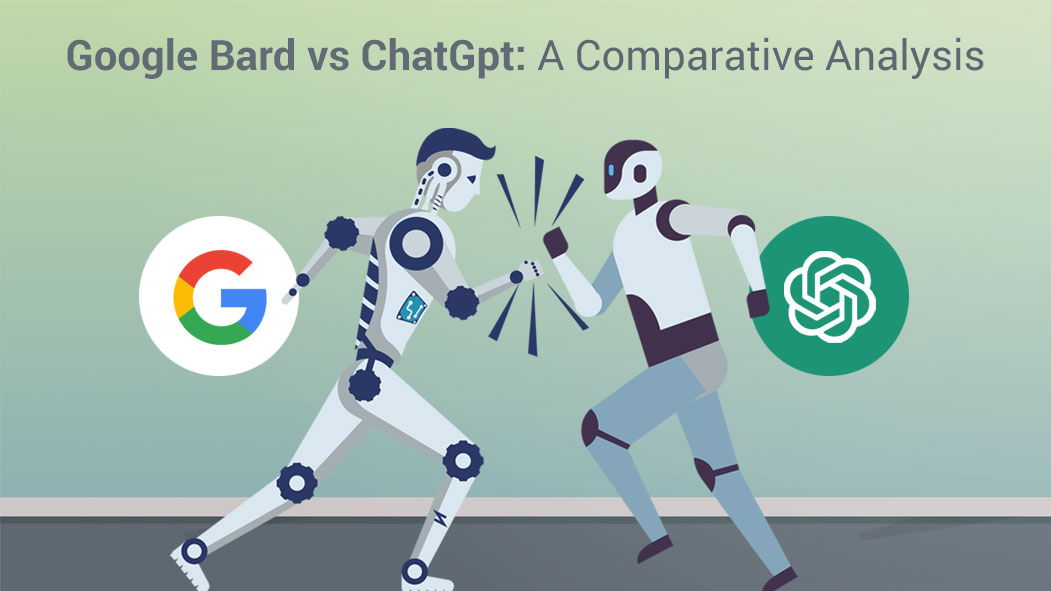March 06, 2023

In November 2022, OpenAI's ChatGPT was released and soon went viral online. Google has now unveiled a chatbot driven by Artificial Intelligence. There are some significant distinctions between Google Bard AI and Open AI's Chat GPT even though both are AI language models. Let us look at both Google Bard and ChatGPT closely.
What is Google Bard?
The newest experimental AI-powered chatbot that can answer a range of questions and requests in a conversational style is called Google Bard. Google Bard is powered by LaMDA, a new language model developed by Google that is based on the Transformer architecture, a neural network design that underpins many of the current AI tools. The release of Google Bard includes a lightweight version of LaMDA that consumes less computing power, allowing more users to access the service and provide valuable feedback. Google intends to incorporate this feedback into its internal testing, further improving the quality of the technology.
Google's chatbot aims to demonstrate its capabilities in handling a wide range of topics by leveraging its power, intelligence, and creativity. It accomplishes this by gathering information from both user responses and the web to deliver highly relevant and accurate responses.
To continually improve its AI system, the chatbot also actively collects feedback from users, allowing it to identify areas for improvement and refine its algorithms accordingly. This iterative process ensures that the chatbot continues to evolve and provide an ever-improving experience for its users.
In summary, Google's chatbot represents a significant advancement in the field of natural language processing, leveraging cutting-edge technology and a user-centric approach to provide highly accurate, engaging, and informative responses to a wide range of topics. Its ongoing evolution and improvement ensure that it remains at the forefront of the rapidly evolving Artificial Intelligence field.
What is ChatGPT?
ChatGPT is a state-of-the-art language model developed by OpenAI that uses cutting-edge deep learning techniques to generate natural language responses to a wide range of queries. As a machine learning AI tool, it has been trained on an enormous corpus of text data to predict the next word in a sentence based on the previous words.
One of the key features of ChatGPT is its ability to understand natural language inputs, allowing users to interact with it in a conversational manner. This is accomplished through a process known as Natural Language Processing (NLP), which involves breaking down language into its constituent parts and analyzing it for meaning.
ChatGPT can be used for a wide range of tasks, including language translation, text summarization, question-answering, and chatbot development. It is highly versatile and adaptable, making it a valuable tool for researchers, developers, and businesses alike.
One of the most impressive aspects of ChatGPT is its ability to generate highly convincing human-like responses to a wide range of queries. This is achieved through a combination of advanced algorithms and sophisticated training techniques, which allow the model to understand the context and generate responses that are both accurate and highly engaging.
As a result, ChatGPT has become a popular choice for businesses looking to integrate artificial intelligence services into their operations, as it provides an efficient and cost-effective way to automate certain tasks, such as customer service and support. With its ability to generate human-like responses, ChatGPT is also useful for chatbots and virtual assistants, which can interact with users in a natural and intuitive way.
Difference Between Google Bard And ChatGPT
Google Bard is a conversational AI designed to provide accurate and original answers to a wide range of topics. It achieves this through the use of LaMDA (Language Model for Dialogue Application), a sophisticated language model developed by Google. In contrast, Chat GPT utilizes the powerful GPT-3 (Generative Pretrained Transformer-3) language model to generate human-like text.
One of the key strengths of Google Bard is its ability to engage in natural and intuitive conversations, making it an ideal AI tool for those seeking quick and accurate information on a wide range of topics. Its vast data index ensures that users receive up-to-date and relevant information in real-time.
Compared to Chat GPT, which has limited knowledge that only extends up to 2021, Bard boasts a significant advantage as it will gather information from the internet's vast collection of data and sources, providing users with the most up-to-date and accurate information available. With its integration with Google's search engine, Bard's access to a plethora of data gives it an edge over Chat GPT, which is supported by Microsoft.
In contrast to Chat GPT , which is known for its tendency to create fictitious content and stories, Bard AI tool is highly regarded for its accuracy in providing users with factual information. This is possible because of Google's massive data collection, which gives Bard AI a significant advantage over other AI platforms, such as Chat GPT, in terms of the depth and breadth of information it can access.
As an artificial intelligence tool, Bard's strength lies in its ability to turn complex topics into easily digestible, chit-worthy chunks that can be understood by anyone, including children. The goal is to promote learning and knowledge-sharing by presenting information in a clear and concise manner. In contrast, Chat GPT responds to text prompts by generating content.
Despite this limitation, Chat GPT's ability to generate human-like text makes it an ideal tool for a wide range of applications, including language translation, text summarization, and chatbot development. However, its responses may not always be up to date, as it is limited by the knowledge it was trained on.
Conclusion
Overall, both Google Bard and Chat GPT represent significant advancements in the field of natural language processing, each with its own unique strengths and limitations. By leveraging the power of sophisticated language models, they have the potential to revolutionize the way we interact with machines and access information in the digital age.

 Academy
Academy






